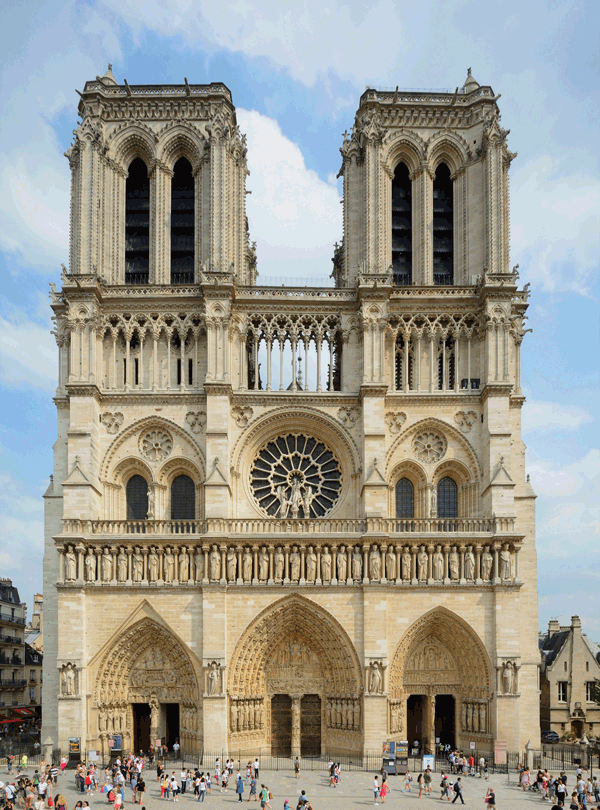
To continue this week on the Paris theme, you will learn about the Notre-Dame de Paris Cathedral and its history, stained glass, organ, and bells. This medieval Catholic cathedral sits on the Ile de la Cite I in the fourth arrondissement of Paris. As the most visited monument in Paris, the Cathedral is host to 12 Million visitors yearly.
On our visit to Paris years ago, my daughter and I saw this magnificent building up close and personal. Just as we saw the Mona Lisa and simply wondered what all the fuss was about just as we strolled down the Champs-Elysees on a cloudless February afternoon! The Avenue, one of the most famous of all the world, was originally laid out in 1667 for 1.7 miles. The avenue has glory and glamour and means Elysian Fields or as someone must have thought “Heaven on earth.” We left Paris on the midnight train to Pisa.
But I digress.
Begun in 1160, the Notre-Dame Cathedral was completed in 1260 with many modifications in the following centuries. Notre-Dame suffered desecration during the French Revolution when much of its religious imagery was damaged or destroyed. Soon after the publication of Victor Hugo’s novel “The Hunchback of Notre Dame” in 1831, popular interest in the building revived. In 1963 the façade of the Cathedral was cleaned of centuries of soot and grime, returning it to its original color. Another campaign of cleaning and restoration was done, 1991-2000.

Wikipedia photo
The Cathedral of Notre-Dame de Paris was built on a site which is believed to have been occupied by a pagan temple and then by a Romanesque Church, the Basilica of Saint Etienne. King Louis VII wanted to build monuments to show that Paris was the cultural and economic capital of France. The cornerstone was laid in 1163 in the presence of Pope Alexander III. The French Gothic style of pointed arches carried the weight of the roof inwards and downwards to a row of pillars, and out to the abutments against the walls.
This Gothic cathedral was a liber pauperum or “a poor people’s book” which was covered with sculpture vividly illustrating biblical stories for the vast majority of the parishioners were illiterate. The exteriors of cathedrals ad other Gothic churches were decorated with sculptures of a variety of frightening grotesques or monsters. These included the gargoyle, the chimera, the Strix. They were part of the visual message for the illiterate, symbols of the evil that threatened those who did not follow the teachings of the church.
The stained glass windows, especially the three rose windows, are exquisitely beautiful. The original glass was recreated in the 19th Century. The windows depict Old Testament subjects. Additional scenes include Christ triumphant seated in the sky, surrounded by his Apostles. Some of the 19th Century grisaille windows in the nave were given new windows.
The organ was built in 1403 by Friedrich Schambantz and was replaced about 1735. The current organ has 115 stops on five manuals and pedal and more than 8,000 pipes.
The bells number 10 and the largest, Emmanuel, original to 1681, is in the south tower and weighs just more than 13 tons. It is tolled to mark the hours of the day and for various occasions and services. Each bell is named such as Marie, Gabriel, Denis, Maurice, or Jean-Marie. New bells were set in place in 2013 and were designed to replicate the quality and tone of the originals.
Under a 1905 law the Cathedral is among 70 churches in Paris that are owned by the French state. With the building owned by the state, the Catholic Church is the designated beneficiary, having the exclusive right to use it for religious purposes in perpetuity. The archdiocese is responsible for paying the employees, security, heating, and cleaning, and assuring that the cathedral is open free to visitors. The archdiocese does not receive subsidies from the French State.

